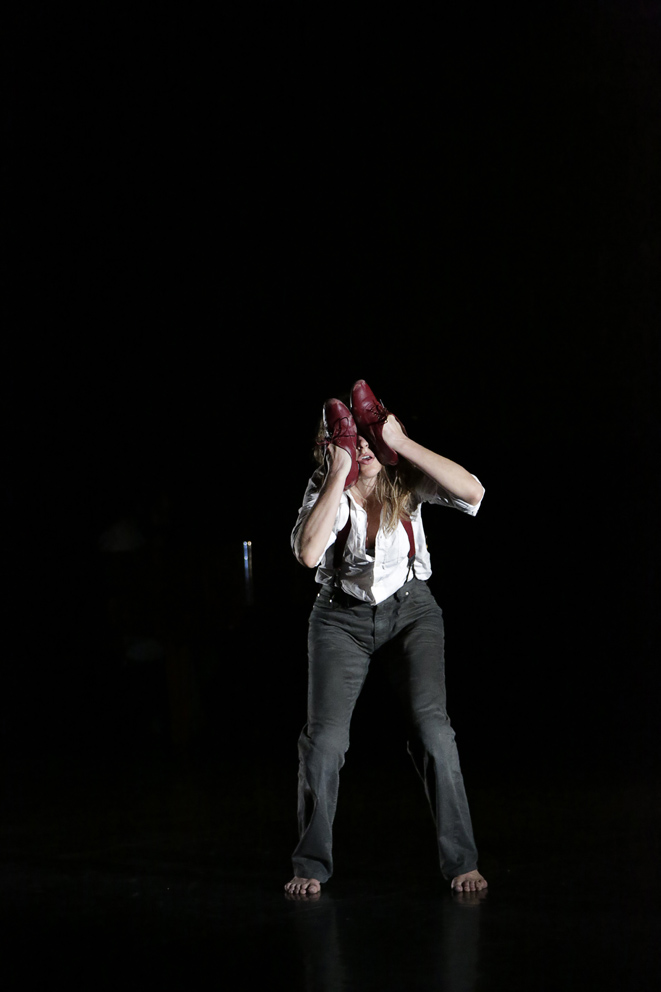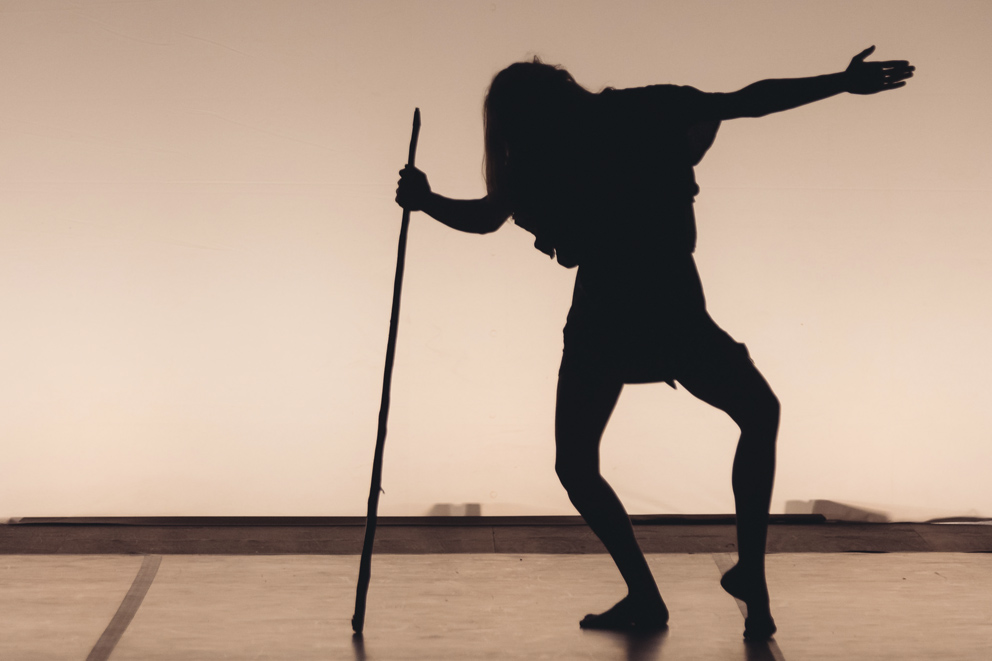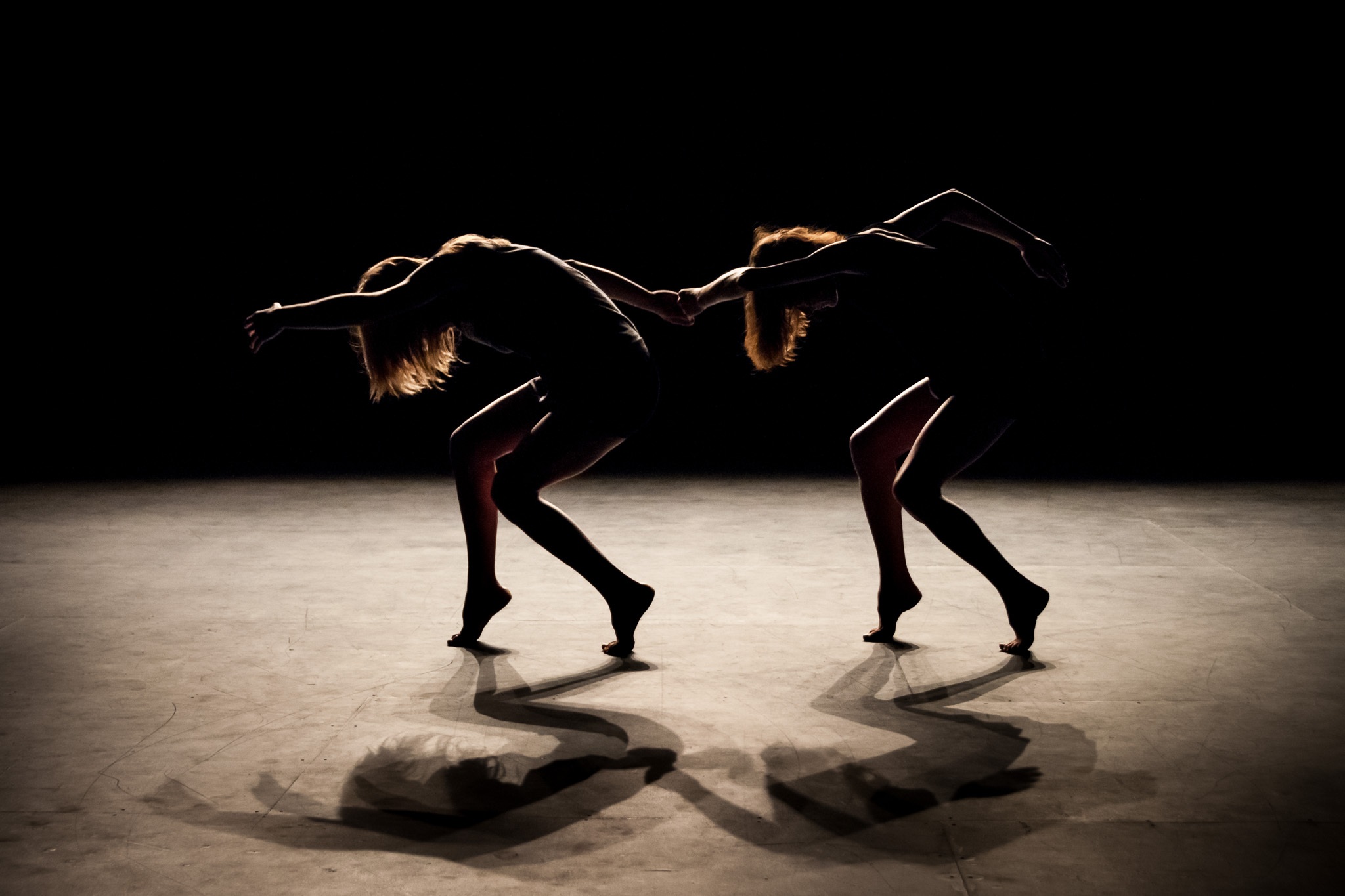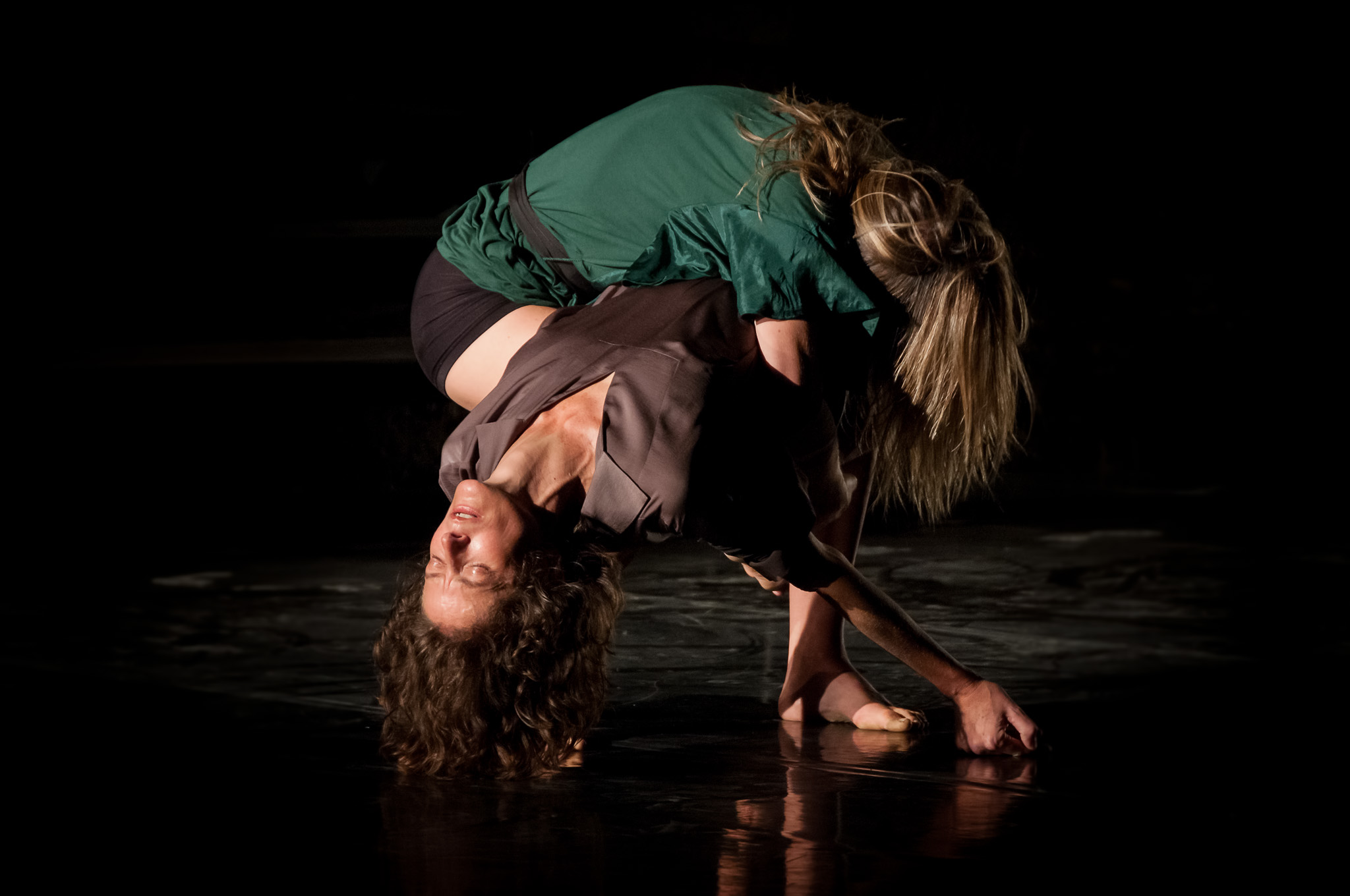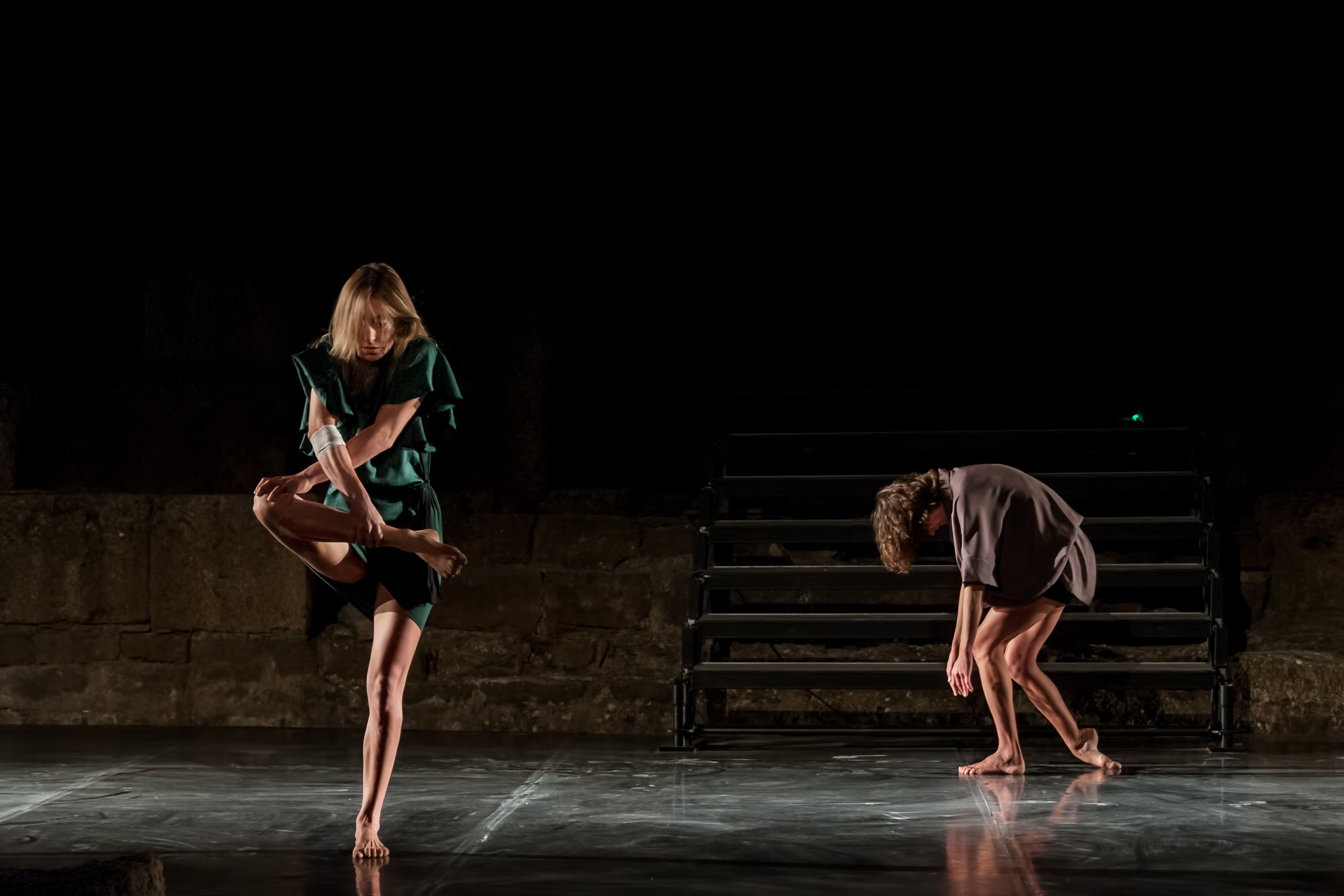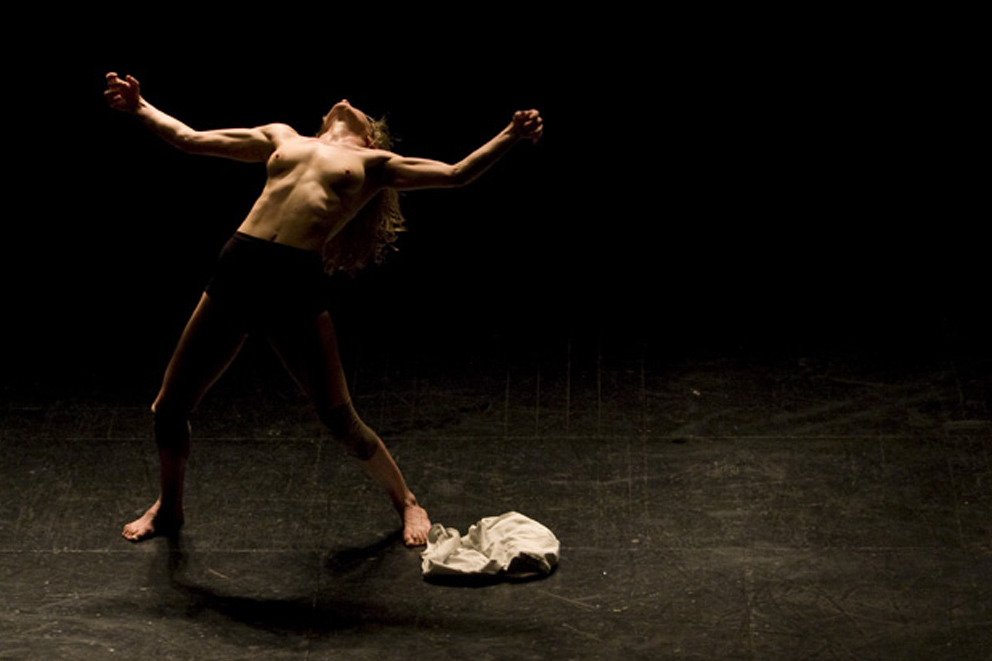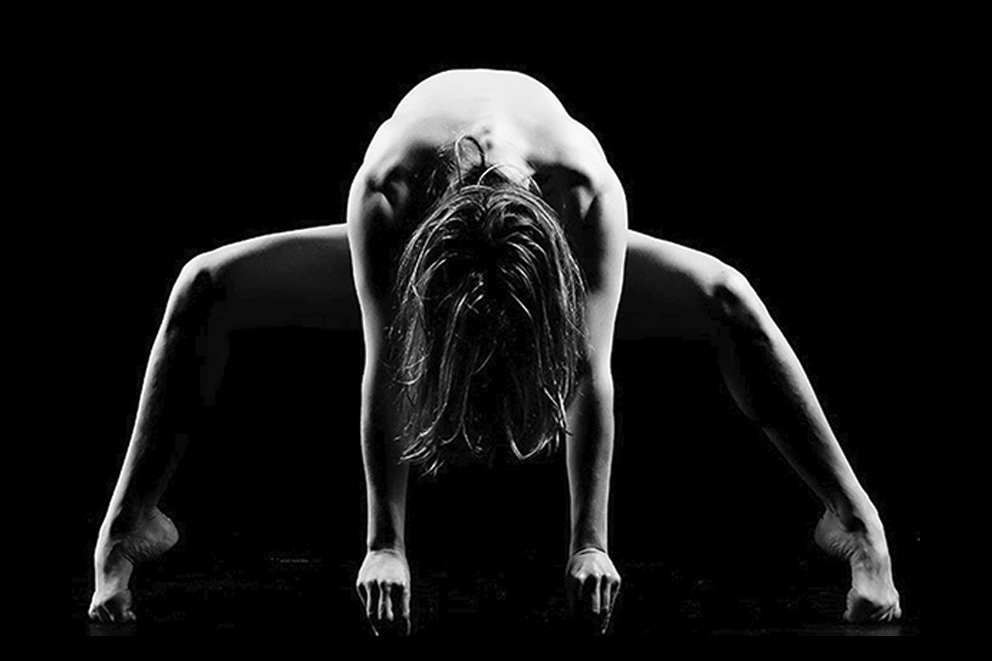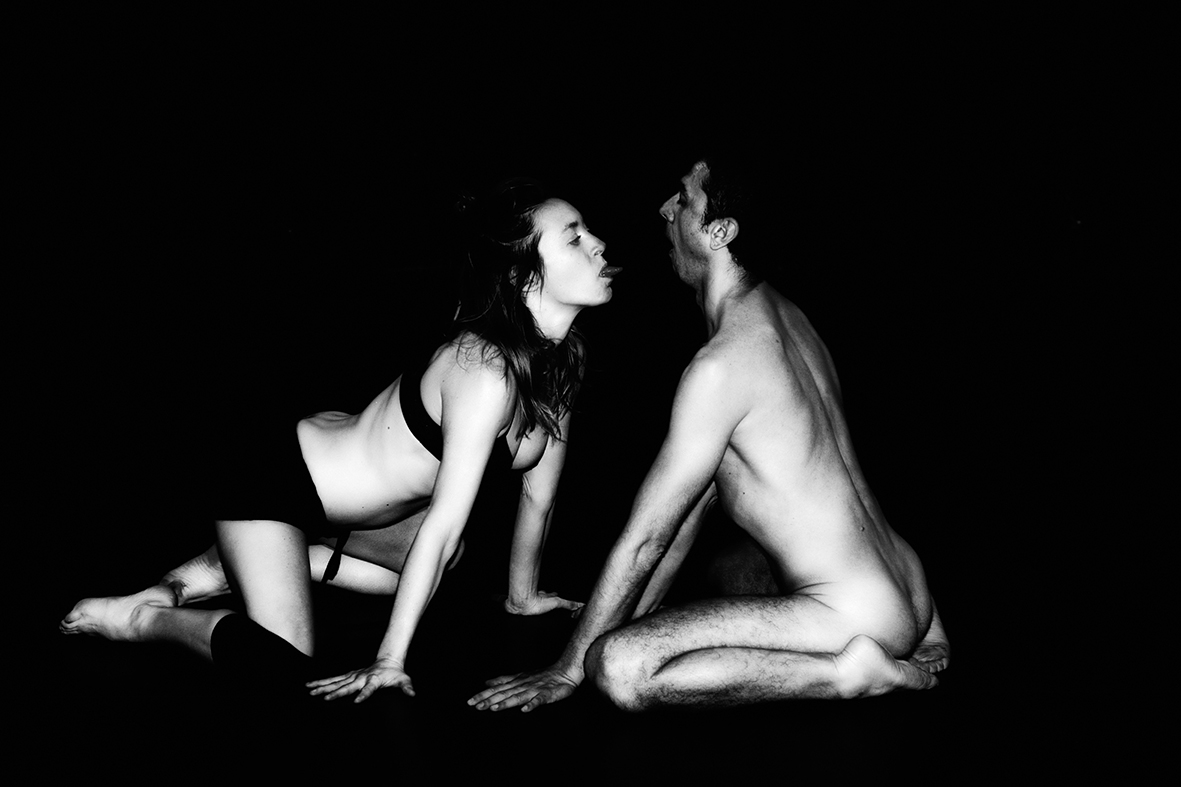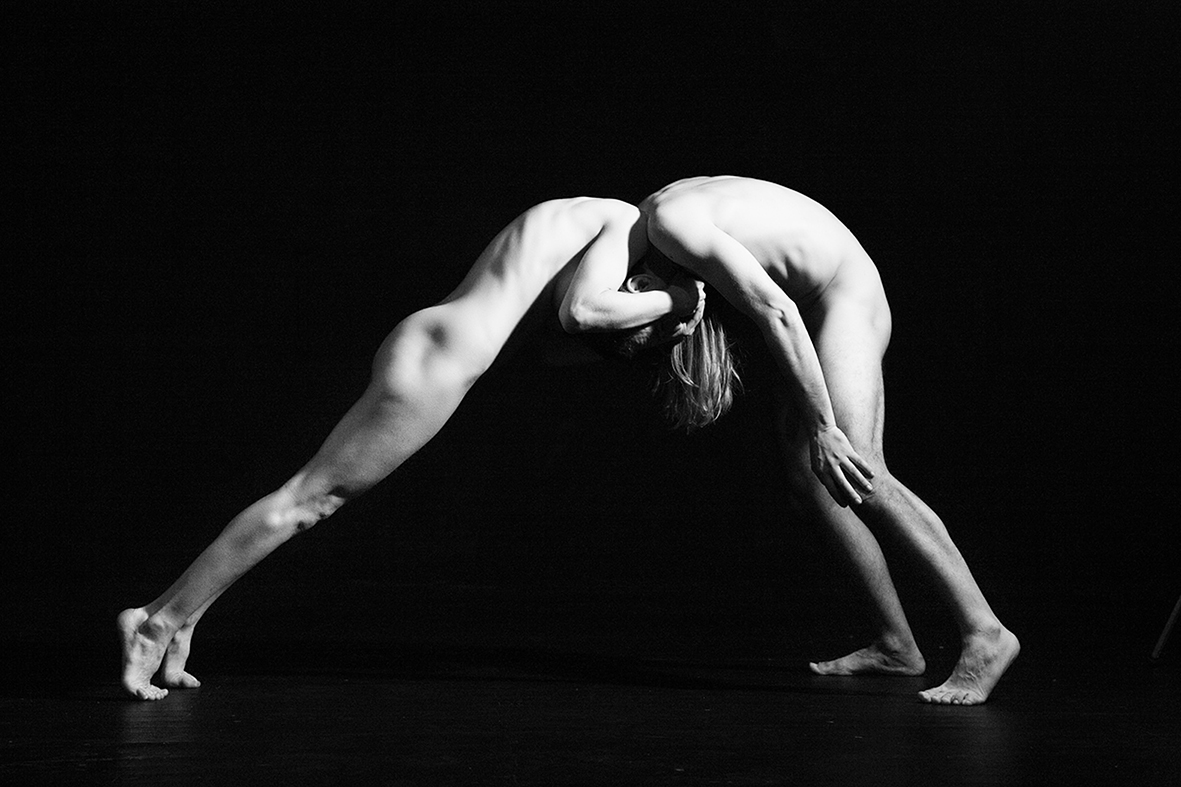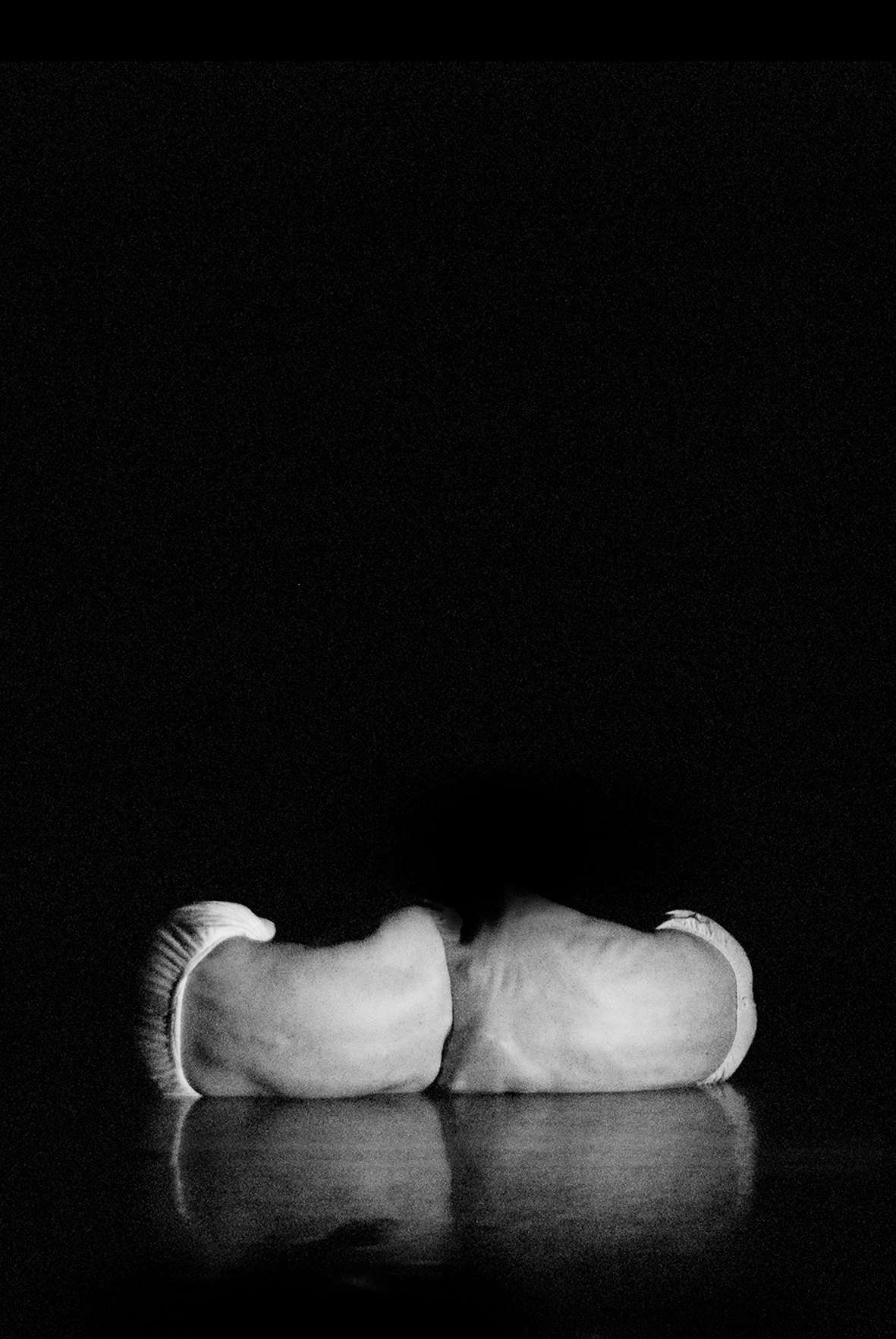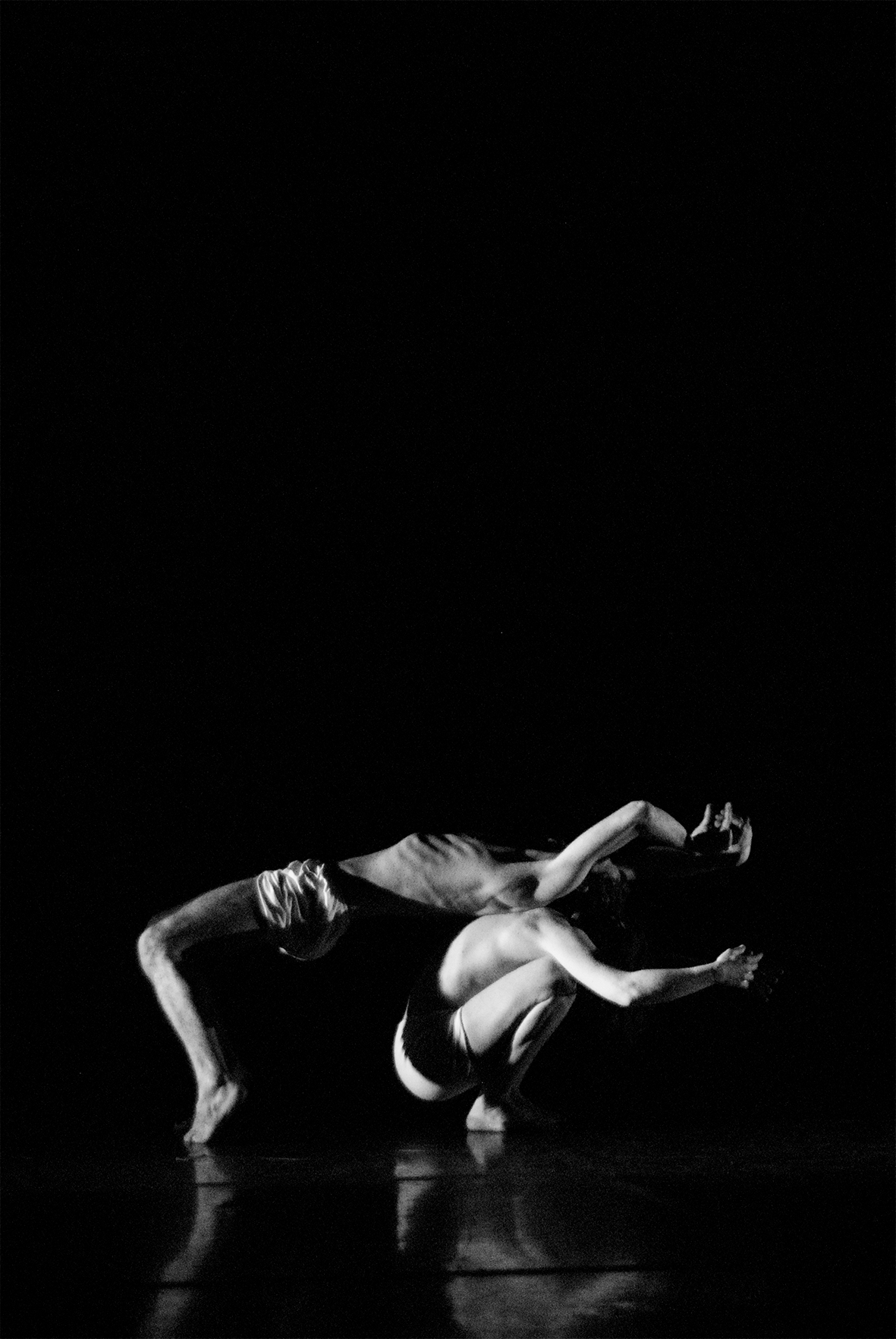Interpretationn: Luz Arcas, Begoña Quiñones, Ignacio Jiménez and Juan Manuel Ramírez Composition and music interpretation: Carlos González Choreography: Luz Arcas Iluminación: Miguel Ángel Camacho Custom Design: Tenkey and Ana Montes Photography: Javier Suárez and Eva Viera Video: Javier Suárez Graphic design: María Peinado Director and Dramaturgy: Luz Arcas and Abraham Gragera.
The Voice of Never
Inspired in Waiting For Godot, by Samuel Beckett
La Phármaco does not intend to illustrate the text but rather to pose a dramaturgy/libretto where the body takes hold of the essence of Beckett’s work, transposing it to the language of dance: the failure of systems to represent what is real, the uprooting of archetypal characters, (without time, without space, without origin and future) who experience love as a fierce and grotesque instinct damning them to existence.
In other words: the tragic feeling of Western Man throughout history.
The Voice of Never confronts these concepts in order to dance a horribly comic contemporary tragedy, as the author himself described it.
The bodies are placed in the desert where the author’s universe leads until that desert becomes a dance. The universe is essentially verbal, or better yet, a consequence of what it is verbal.
The music, composed and performed live by a pianist, constitutes the sound space of this work. In this way conceiving of it in its corporal dimensions, taking precedence over the expressive and poetic ones. The accompanying score is Beethoven’s second movement sonata ‘Moonlight’ and the third movement of Shostakovich’s ‘Sonata for Viola and Piano’ compounding an original sound space based on the links that exist between these two works.
The project is supported by the Regional Government of Andalusia “Agencia Andaluza de Instituciones Culturales” and by “The Dance Center” of Teatros de Canal, Madrid.
Premiere at Feria de Teatro del Sur, Palma del Río, Córboba, July 2014
“Beyond the unrelenting beauty of the staging and the overwhelming technical skill, I can’t remember seeing a Beckett this pure, nor this necessary”
Exodus: First Day
Inspired by Oedipus at Colonus and Antigone by Sophocles
The work is structured into danced episodes and stasima (choral interventions), that tell the story of Oedipus and Antigone’s journey to the forest of Colonus, Oedipus’ death and Antigone’s return to the city of Tebas.
The dance is inspired by ancient Greek iconography, the music is original, performed on stage by a soprano, woodwinds and percussion, part of musical recreations from this era.
This work is supported by Centro de Danza Canal, and was nominated for the Premios Max and Premios del Teatro Andaluz (2014) or Best Dance Performance and best female dancer (Luz Arcas). It is part of the AECID catalogue (2015).
The world premiere of Exodus: First Day was September 2013 at the Roman Theater of Baelo Claudia (Bologna).
Dance: Luz Arcas, Regina Navarro and Ana Catalina Román Interpretation and musical composition: Laura Fernández, Voz, Corifeo Mariano Peyrou, brass and Xosé Saqués, percussion Choreography: Luz Arcas Lighting: Jorge Colomer Custom Design: Rosa López Fotography: Javier Suárez Graphic design: María Peinado Dramaturgy and Scenic Direction: Luz Arcas and Abraham Gragera
“It is a mature and elegant performance, with a very sober structure and a series of balanced elements(…) The piece is an intense poetic force(…) The theme of this performance is merely a pretext, a way of approaching the classics with a latent modernity: the ancients as a patrimonial burden, moral disaster as our main inheritance and perhaps guilt in the form of a suicidal shadow”
“ELuz Arcas’ solo with a staff is one of the most beautiful things that yours truly has seen on stage. The journey to the seed becomes fruitful. Becoming pregnant is a delight”
Thirst Erodes
A piece in three acts for dancer and soprano. A physical and poetic reflection based on the classical mythology of Kore (Persephone’s name as a girl, before being abducted by Hades, as also interpreted in Eros and Psyche’s soul’s condemnation to exile) and Eros Psicompo (who takes the souls to the underworld).
The concept of the choreography stems from intuition: when a body dances, all other bodies (past, present and future) dance with it. All of these anatomies keep a memory of the rest of the anatomies. The physical language of Time is contained within the body itself.
The project has received the support of Canal Dance Center (Madrid).
Thirst Erodes was premiered at the Instituto Cervantes in Casablanca, May 2012.
Interpretation and Choreography: Luz Arcas Voice: Laura Fernández and Rosa Miranda Lighting: Jorge Colomer Fotography: Celia Mondéjar and Raúl Barrio Graphic design: María Peinado Dramaturgy and Scenic Direction: Luz Arcas and Abraham Gragera
“With a sober and profound composition, Luz Arcas involves time and space in a synthesis lasting just long enough. The live music, an a cappella soprano, imbues the scenes with a sense of ritual, contributing a sense of distant elegance. Working on the concept of the solo in dance brings the dancer to a confrontation with an imaginary, enormous referential mirror”
“Luz Arcas offers up colossal physical dedication, awakening in the audience not only an admiration for her artistic honesty but also an elegiac feeling which imbues ones spirit in an unshakeable manner”
Before , it was Always Fire
Before , it was Always Fire dances the need to construct ourselves within a world, to be an image and likeness, for us to understand precarious forms and attempt to keep them under control. It is the hour of the forge, the fire, the blow and the material, an encounter with submissiveness, the incarnation of feelings and directions.
Two bodies that, rather than dance, are danced. They become docile, anatomical mirrors awaiting a physical correspondence, withstanding the fleeting moments, sustained in fragility. Condemned, always, to be the seed, to be ever vigilante to the possibility of connecting, as if this were beauty’s last hope.
Before, it was Always Fire was inspired by the myth of Prometheus as well as the writings of Heraclitus and Paracelsus. On stage the dance is accompanied by original scores by Henry Purcell, interpreted live by a soprano, viola da gamba and theorbo.
This work premiered at the Festival Escena Contemporánea (Madrid) in February of 2012.
Interpretation and Choreography: Luz Arcas and Koke Armero Sound Space: Illo Muriel Music Interpretation : Manuel Casas, theorbo, Rosa Miranda, voice and Illo Muriel, viola da gamba Original Music: Henry Purcell Lighting: Diego Domínguez and María Otero Custom Design and Scenic Space : La Phármaco Custom: Eva Arinero Scenography: Israel Muñoz, Muneka Producciones and Koke Armero Fotography: Raúl Barrio Graphic design: María Peinado Direction and Dramaturgy: Luz Arcas
The two-backed monster
The two-backed monster eis inspired by Plato’s Symposium, specifically focusing on the myth of androgynous narrated by Aristophanes: We wish to bring desire to movement. To construct dance from desire and its sickness. Two bodies that surrender themselves unconditionally, until losing their form, until they become deformed into a two-backed monster. They inhabit the excesses of their new anatomy.
We want to dance the erosion of desire, over time subdue the monster, dancing the journey from physically coming together to falling apart, to stop amongst the fracture: each bodies return to its unique anatomy. Alone, each body dances its requiem. Wailing for its lost half.
The desperate act of loving what is far away.
This work premiered at the Pradillo Theatre (Madrid), in March 2010.
Interpretation and Choreography: Luz Arcas and Koke Armero Sound Space: Illo Muriel Lighting: Luis Enrique Soria Design and Scenic Space: La Phármaco Fotography: Gustavo Rebollo Graphic design: María Peinado Direction and Dramaturgy: Luz Arcas






